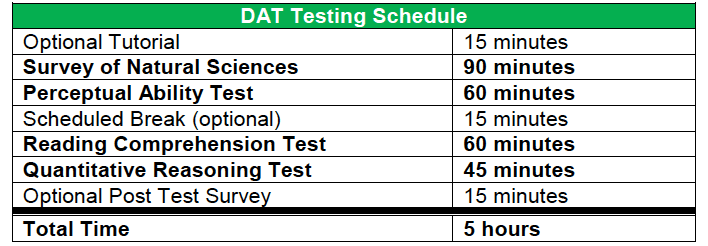If you want to begin your career as a dentist, taking the Dental Admissions Test (DAT) is one of the most important steps on the way. The Dental Admission Test (DAT) is a standardized exam, consisting of multiple-choice questions and clinical simulations intended to assess your potential for success in dental school.

Taking the Dental Admission Test (DAT) can be intimidating, and it is easy to become distracted and overwhelmed.
Using effective and proven strategies and test-taking tips for both the multiple-choice and written sections of the DAT can help you score well and pass the DAT on your first try.
Thousands of the best and brightest students each year take the DAT in hopes of securing a place in one of the many dental schools across the country. If you are preparing for the DAT and need help deciding when to take the test, you've come to the right place.
When we say: we make preparing for the Dental Admissions Test (DAT) easy, we mean it!
The Dental Admission Test or DAT is one of the steps you must take to get into a dental school in the United States or Canada. It evaluates your scientific knowledge and your academic capability.
There are four sections of this computerized test: Survey of Natural Sciences, Perceptual Ability, Reading Comprehension, and Quantitative Reasoning.

The purpose of the test is to assess an applicant’s knowledge and skills of introductory material in the biological and chemical sciences.
There are 100 questions in the overall basic sciences section, divided into 40 biology questions, 30 chemistry questions, and 30 organic chemistry questions.
Each category will have a separate score. You have 90 minutes to complete this section, which gives you 54 seconds per question.
To succeed on the test, it is essential that you answer all questions in a timely manner. You are not penalized if you guess on questions, so it is best not to leave any questions unanswered. It is an independent set of questions that do not have multiple answers.
The Perceptual Ability Test helps you determine your perceptual abilities, including your ability to visualize and manipulate objects mentally in three dimensions, as well as your ability to detect small changes in the angle of a line.
Achieving a high score on this test suggests that you have a very good level of perceptual ability. A point to note is that you will not be able to use any sort of measuring instrument, whether it be a scale or pencil, or even your finger.
This section is ideal for gaining ground and improving your academic performance. Your score is broken down into three separate scores for each of the sciences.
Reading comprehension and quantitative reasoning scores are also averaged with these three scores for your academic average. The two major scores you will receive are academic average and spatial ability.
You have 60 minutes to read three passages and answer 50 questions. Several different topics are highlighted in the passages, such as science and economics. Although you cannot learn the content of the passages in advance, practice is essential.
If you wish to master this section, use a preparatory book. It contains tips for skimming and highlighting sections to maximize your time. Rather than focusing on one answer, answer as many questions as possible.
During this section, the computer screen offers a four-function calculator only. The 40 questions will be spread out over the following areas: algebra; data analysis, interpretation, and sufficiency; quantitative comparison; and probability and statistics.
A simple twist is usually involved in the calculations. Your quantitative reasoning score can be improved by practicing the various types of questions.
The timing of this section is equally important as other sections. Stay focused and do not spend too much time pondering a question.
Applicants should have at least one year of college education, including general and organic chemistry, biology, and physics. There is no requirement for advanced biology and physics.
Applicants should be aware that the test scores are developed according to the number of examinees taking the test.
Most applicants have completed two or more years of college before taking the test. It is recommended that prospective dental school applicants take the DAT Program well before their intended dental school enrollment.
For candidates applying to Canadian dental schools, it is important to make sure the school accepts a DAT score. Applicants may only take the test 3 times before requiring special permission if they wish to take the exam again later. It is necessary to wait 90 days before retaking the test.
It's important to wait until the right time to register for the DAT. We don't recommend signing up for this test at any time. You can only take the DAT three times, and you need to wait 90 days before taking it again. That is one factor to consider when you are deciding when to take the test.
Generally, students should have finished all of their required courses by the end of their sophomore year and may take the DAT prior to entering their junior year. However, if you are not confident about taking the course at that time, you can always postpone it.
It's best not to rush the DAT if you aren't ready since you won't be applying to dental schools until your senior year. DATs can be taken after your sophomore year or after your junior year, and each approach has pros and cons.
The DAT can be taken during the summer immediately following your sophomore year, which will allow you to submit the DAT scores along with your application the following summer.
The fact that you just finished your Biology and Chemistry classes will help you study and perform better on the DAT, as you will have more knowledge about them.
You don't need to worry about preparing your application until next summer. Focus on just the DAT. Additionally, if necessary, you will have a year after submitting your application to retake the DAT, but do not ever consider retaking it.
If you are ready, get it done in one go.
You stand to gain a greater depth of knowledge and experience if you take the DAT the summer after your Junior year as you have had more time to take elective courses.
The following elective courses can help you to benefit from taking the DAT, including Anatomy, Physiology, and Zoology. The majority of the DAT is made up of General Biology and Chemistry courses, which are usually completed after their sophomore year.
As you will not have fresh memories of the content, you will likely have to spend more time studying and revising the material if you wait until your junior year to take the DAT. It is also imperative that you complete and submit your application within a few days after the application period opens.
If you have not taken the DAT by the time the application cycle opens up during your senior year, you will have to balance studying while applying.
The most ideal time to get your application ready and submitted is shortly after the application cycle opens, and you should take the DAT once your application is submitted if needed. Take the DAT by July of that summer if you can.
Plan out your entire undergraduate career for all four years so you know what classes you'll take each year and even every semester. Taking the DAT and applying for a dental school will be easier if you have taken the prerequisite courses ahead of time.
Sit down before starting the first semester of your undergraduate study and plan out the courses you will need to take each semester.
When you are ready to take the DAT, make sure you have completed the required classes. After passing the DAT, take any additional elective courses needed for dental school. Being proactive and practicing this will enable you to prepare for the DAT properly and help you reduce stress.
It is recommended that you delay taking the DAT if you haven't completed the required courses. The DAT should not be taken without extensive preparation.
The average undergraduate student enrolled in dental school takes around 20 credits per semester. Plan to take more credit in some semesters as a way to demonstrate your ability to handle a heavy load, but stay focused on doing well in your classes.
Keep a balance between your course workload and your grades, so that you can still receive good grades.
Prior to taking the DAT, the following courses must be completed: General Biology, General Chemistry, and Organic Chemistry.
You will benefit or be required to take the following courses for the DAT or dental school:
You can find the DAT Official Guide on the ADA website. The website contains information about the content covered on the exam, testing procedures, as well as information about how to apply and score on your exam.
To qualify for the exam, you will have to read and agree to this document. However, we recommend you read it early in your preparation process so that you can accurately aim your efforts.
You should prepare for your DAT for about three to four months before taking the test. Our previous students found it beneficial to study for a minimum of 3 hours per day for 5 days out of the week (roughly 200-250 hours).
However, your study schedule may need to be customized to meet your individual needs.
Take a break every once in a while studying. Don't be distracted by technology, go for a walk and stretch. Breaks can be both physically and mentally healthy for you, helping you to refocus.
Prepare a study plan that fits your needs by studying all four sections of the DAT. If you feel you have a good grasp on the subject but have a weakness in another, spend more time studying that area. Practice tests are a great way to prepare. Use the DAT prep books and courses available to you.
You can obtain all four tests used in the DAT by downloading the DAT preparation materials from the official website. Candidates can download these materials free of charge to discover where they may be lacking in their understanding of topics discussed on the test.
The tests also provide an opportunity for students to learn about the types of material included in the test and how the different parts work together. Despite the absence of sample DAT content, the tutorial enables you to become familiar with how the test is structured and the steps involved in responding to questions
Candidates will also be able to take a brief optional tutorial before beginning the actual test at Prometric's Test Center so they can better understand the workings of the computer.
The score reports will typically be sent out 3-4 weeks after the application has been submitted to the institutions that were requested.
You can retake the test. There is a fee for each test attempt, and you have to wait 90 days between tests. You have to submit a written request to the ADA to get approval if you need to take the test more than three times.
Two forms of identification will be needed to verify your identity. It is forbidden to bring writing stationaries, calculators, and electronic devices to the testing center. Everything else you require will be provided there.
Study smart for your exam day! DatPrep will help you study smarter and not harder. You'll get free practice test questions and DAT practice tests to get the best online Bootcamp experience.
Sign up today and get the most out of its resources!